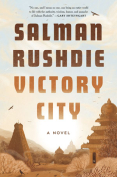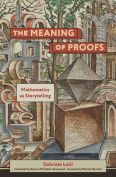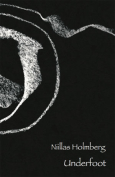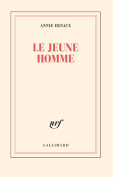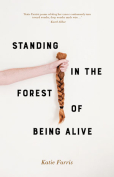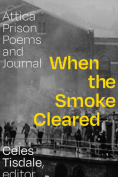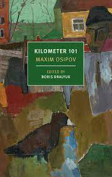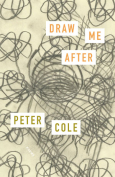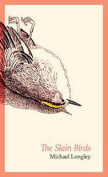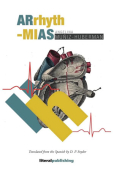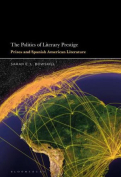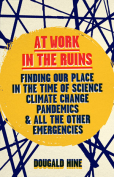At Work in the Ruins: Finding Our Place in the Time of Science, Climate Change, Pandemics and All the Other Emergencies by Dougald Hine
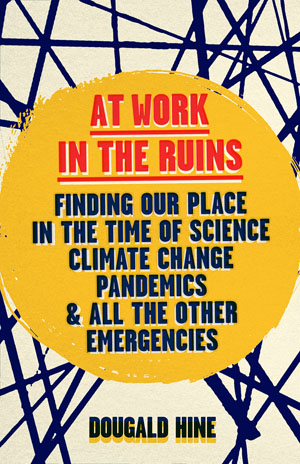 White River Junction, Vermont. Chelsea Green. 2023. 224 pages.
White River Junction, Vermont. Chelsea Green. 2023. 224 pages.
With an unwieldy subtitle for a somewhat unwieldy book, At Work in the Ruins is largely a continuation or an updating of an essay Dougald Hine co-authored with Paul Kingsnorth in 2009, “Uncivilisation: The Dark Mountain Manifesto.”
At Work in the Ruins is wide-ranging, drawing from a myriad of conversations, talks, books, and observations. It is not a hopeful book, and an overarching challenge seems to be responding to the charge that he and Kingsnorth have surrendered, have given up any hope of ultimately coming out on top in this time of great crisis.
The context for the book: Hine’s better-known colleague, Kingsnorth, set the stage more than a decade ago. Turning away from his Dark Mountain activism, Kingsnorth decided that environmental collapse was inevitable. He became quite sympathetic to Brexit, and later to the anti-vaxxers; he converted to the Romanian Orthodox Church. Kingsnorth’s change of orientation was rewarded by New York Times Magazine with a long, favorable piece titled “It’s the End of the World as We Know It . . . and He Feels Fine” (2014).
Hine has not gone as far off the rails as his close colleague, but it is clear that he is no longer a battler against the deepening Dead Zone that is today’s reality. One giveaway is his constant use of the term “climate change,” on pretty much every page of At Work in the Ruins. Climate change is a weak euphemism for the unfolding overall catastrophe, a telling usage.
There are, however, worthy explorations undertaken in the book. Hine repeatedly returns to science as a problematic project rather than as some kind of saving grace. He not only claims that we ask too much of it but that the culture of science is itself limiting. Hine suggests that the Covid pandemic presented us with a fork in the road, the possible emergence of a new politics of science. He points out that science has not proven to be an effective safeguard against misinformation but does not provide much as to what a new way of approaching science would look like.
At Work in the Ruins acknowledges that science “is behind the project of making this living planet into an object of technological management and control” but doesn’t linger with that insight or develop it. Hine also notices, in passing, the costs of industrial modernity and asks, “Is this the way to inhabit a planet?”
Hine surveys some of the shallow and false paths to comprehending or challenging our predicament—and then follows suit, in my opinion, with a major failure of his own. Fifty pages in, he sees 2018 as “a great opening,” with the appearance of Jem Bendell’s Deep Adaptation thesis and the emergence of the Extinction Rebellion protest movement. But the two phenomena seem contradictory or opposed. Bendell sees collapse as inevitable, while Extinction Rebellion counsels nonadaptation: “In the face of extinction, we say Rebellion!” In January 2023 E.R. abandoned disruptive protests as a tactic and hasn’t offered much by way of radical analysis.
Hine lauds Greta Thunberg and Joe Biden in his chapter “Here Come the Grown-Ups.” Odd choices for a liberatory future. Thunberg represents moral protest minus action, and Biden is a more than obvious case of status quo as matters get graver ever faster.
Hine hops around throughout the book with scores of passing references to recent years. In search of a contrasting energy, he might have considered going back a bit further: to the antiglobalization movement of 1999–2001, for example, that raged in such places as Eugene, Seattle, Quebec City, Prague, and Genoa. That last location saw three hundred thousand in the streets and all-out fighting. No mention of this phenomenon by Hine.
In the chapter “Shades of Denial,” Hine debunks the idea of “green growth.” But he spends much more time on the Covid pandemic, and it is clear that he doesn’t wish to offend the anti-vaxx folks. He seems to fear the authoritarian potential of public health measures taken against the disease and minimizes the fact that millions have died and are still dying of Covid. He adds an inadequate caveat, “Not for a minute do I wish to diminish the reality of anyone’s suffering.” Seven vaccinations are required to enter the US military. It strikes me that the anti-vaxx sentiment always hovers near “conspiracy theory” territory.
At places in the book, radical insights appear, but consistently as afterthoughts. For instance, there is much on the fatal characteristics of modernity but little or nothing on the logic of how we got to this state of affairs. Hine declares, “We can no longer afford to organize our societies according to the extractive approach to the world.” Here is an opening to the topic of productionism, but it is left hanging. “How to Give Up” is chapter 23’s heading, echoing the charge of surrender. It does, however, counsel a local approach, a decoupling from the dominant, centralized order.
Along with references to his pal Kingsnorth, Hine also refers favorably to Ivan Illich, who pointed out various foibles and false promises of modernity. Hine mentions meeting David Abram (author of The Spell of the Sensuous) but says nothing of the depth of Abram’s critique of symbolic, alphabetic culture.
Openness is a cardinal virtue for Hine. Surrender? “Yes, to the mystery, not the certainty.” We need to be wary, to listen. Modernity is “messy and questionable,” but this “is not to suggest that we ought to go back to any pre-existing state of affairs—as if that were an option.”
At Work in the Ruins only finds more ruins to come. It is critical at times but, more fundamentally, carries an underlying theme of acceptance of the suicidal endgame of civilization.
John Zerzan
Eugene, Oregon
